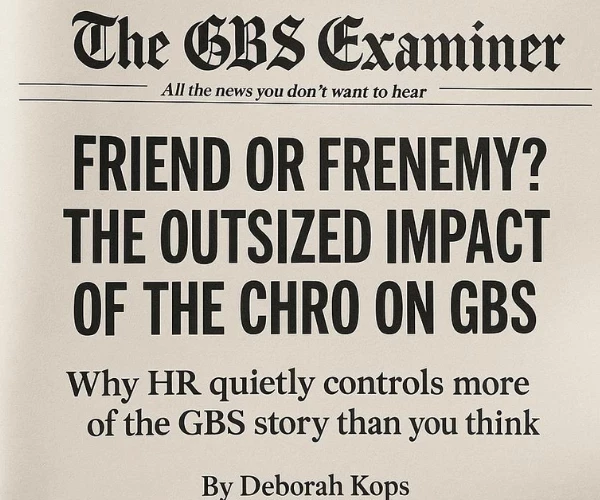Enterprise Experience Management: The Next Frontier for Global Business Services
Add bookmark
The Case for Experience Management
Global Business Services (GBS) leaders are exploiting a unique opportunity to enhance their value to the overall enterprise by becoming the “go to” organization for experience management. Experience management has emerged as a distinct capability focused on measuring and improving the experiences enterprises provide to their customers, employees, suppliers, and other stakeholders. It builds upon traditional customer and user service improvement techniques. It differentiates itself by emphasizing hyper-personalization through alternate delivery channels and utilizing advanced data and digital tools.
The benefits of a structured experience management program are supported by numerous research studies as demonstrated by the sample below:

Figure 1. Impact of Employee Experience by the Numbers
The COVID-19 pandemic further fueled the need for experience management. Employee well-being and staying competitive with new ways of interacting virtually with all stakeholders have taken center stage.
GBS is Well-Positioned to Orchestrate Experience Management
GBS organizations are starting to take up the mantle. Deloitte’s 2021 Global Shared Services and Outsourcing Survey Report cites that 54% of GBS organizations have either implemented or are planning to implement customer experience and user-centric design as a capability.
GBS organizations are uniquely positioned to deploy experience management capabilities both for their own services as well as for the full enterprise. The rationale is that many of the services GBS organizations provide are central to stakeholder experience. For example, a GBS organization with customer service and revenue cycle management activities is naturally positioned to provide customer experience management. Similarly, those GBS organizations offering hire-to-retire services are ideally positioned for employee experience management. And GBS organizations with full source-to-settle services are naturally positioned for supplier experience management.
But beyond applying experience management capabilities to their own services, multi-functional GBS organizations are often well suited for offering experience management as a service across the enterprise. A fundamental inhibitor to improved stakeholder experience is that organizational units tend to work in their own silos to optimize their piece of the pie, rather than the full experience. GBS organizations are one of the few in a company that are accustomed to working across organizational boundaries.
For the remainder of this article, we will delve deeper into establishing an enterprise experience management capability within GBS organizations. We will focus on employee experience management as illustrative, although most of the concepts apply to other experience management domains.
Experience Focus Requires a Strong Operating Model for Enterprise-wide Coordination
Experience is composed of interactions with people, systems and data that deliver the end-to-end business processes. GBS organizations have increasingly organized delivery around these end-to-end processes, creating a compelling opportunity to orchestrate the experience of the consumers of the service.
Enterprise-wide orchestration requires a federated model across the enterprise. Experience management lends itself to a center of excellence (COE) model similar to other emerging GBS capabilities as outlined in SSON’s article The Rise of Digital COEs in GBS Organizations. GBS coordinates and orchestrates activity across multiple groups as depicted below:

Figure 2. Operating Model for Enterprise Experience
Executive leadership’s support for the cross-functional alignment required to pursue enterprise experience strategies is critical. Robust governance to set direction, priorities, resources, and budget is prerequisite for sustaining success with enterprise-wide experience improvements.
The strength of this operating model is its leverage of the GBS skills, capabilities, and stakeholder relationships to actively manage, champion, and deliver holistic enterprise experiences. By engaging the cross-functional teams in the development and implementation of experience initiatives, the COE aligns and phases execution to prioritize enterprise impact.
The Necessary Talent Equation for CoE Success
When building a COE, it’s important to consider the talent equation needed to deliver value. Successful COEs share the following characteristics:
- Clear charter and mandate
- Lean, empowered, and agile team mindset
- Able to activate function and domain experts across the functional domains.
- Access to budget and able to prioritize cross-functional goals above functional ones to achieve the enterprise goals.
It’s important to keep a tight focus on building key capabilities, rather than aggregating all resources, in a COE. Key capabilities include:
- Program Management to organize portfolio of projects, track progress across identified journeys and engage network of experts to support journey mapping
- Change Management and Communication to monitor consumer and stakeholder sentiment and concerns, build engagement strategies and monitor success and adoption of experience changes
- User Experience (UX) and Graphic Design tools, methods, and practitioners to establish and maintain UX standards, prototype new experiences, coordinate journey mapping and improvements
- User Research to identify and consolidate existing user data, conduct employee listening exercises, coordinate journey mapping, synthesize results and identify patterns and trends across and between journeys
- Data Architecture to identify, connect and leverage user data to improve the employee experience through personalization, prediction, and automation
A strong link to the IT architecture is also required. Ideally, the architects who set standards for access, security, tools, and technologies reside in the IT organization and have a strong connection to the COE to align with enterprise priorities.
Keeping the COE small and lean requires it to engage and activate extended teams to pursue journeys that involve and impact multiple functions. The benefit of this approach is access to domain-specific knowledge and skills to execute the work. It allows for stronger change management, with extended team members shaping the work and acting as change agents within their functions to articulate the strategy and its benefits, align goals, and drive execution.
Mapping the Journey: Tools and Methods to Capture Experience
Journey mapping is the practice of visualizing and documenting the touchpoints your consumer goes through to accomplish a task or goal. A key first step is to clearly identify the user persona or personas – the user from whose point of view you’re viewing the journey.
The journey mapping technique and tools complement process mapping techniques commonly seen in GBS. Global process owners (GPOs) have successfully used business process tools and techniques to remove bottlenecks and redundancies, reduce inefficiency and increase scale. These tools generally focus on the process itself and seek to streamline interaction between people, systems, and data.
By contrast, experience and journey mapping puts focus on the consumers of the process and considers the inputs, effort, and efficiency from their point of view. Process and experience focus complement and balance the focus to ensure process improvements don’t overburden consumers and experience enhancements don’t create undue process burden.
Case Study: The Internal Support Experience
Journeys that may be addressed by the COE include onboarding, manager experience, travel and expense, go-to-market, and pre-to-post sales. Leading companies identify key journeys by listening to employees and interviewing internal-facing leadership. This case study examines an experience that is often a source of employee frustration: the internal support experience.
Generic Global is a Fortune 100 multi-national company that provides products and services to Enterprise customers. Jack has been the COO for the last few years and is proud of the process and infrastructure improvements the team has made. However, at the start of a new fiscal year, both Sales and Human Resources (HR) leaders are raising complaints about the tools available for sales compensation. While Jack is reasonably sure the tools are functioning as promised, he asks the team complete journey mapping with Sales Managers to understand the experience from the consumer’s point of view.
The team begins talking directly to the sales managers and uncovering insights. They quickly homed in on a group of sales managers with team members who work in specific countries. One of those managers, Mary, was outspoken and active in the journey mapping session. She had been given the opportunity to provide a salary increase to several of her employees. To determine where to distribute funds, Mary researched her team’s total compensation and performance. She logged into the sales tracking tool to view goal achievement and commission levels, and then switched to a newly deployed Human Capital Management (HCM) system. In the HCM, Mary could see salary data, but noticed that the compensation ratio, which compares an individual employee’s salary to the midpoint of the salary range, was missing for some employees.
Mary has two days to enter a recommended raise and wants to make an equitable, data-driven decision. When opening a support case, she is first asked to identify whether her issue is related to HR, IT, facilities, or sales support. Unsure of where her problem lies, Mary opens a case with Technical Support (IT). Several days passed without any contact or updates; frustrated and out of time, Mary entered values based on gut rather than data.

Figure 3. Internal Support Experience Flow from User Point of View
Behind the scenes, it turned out this wasn’t a technical issue at all. HR was waiting for Sales Operation to provide guidance on compensation ratios in the smaller countries -- hence the missing values in Mary’s view of data. Technical Support didn’t know where to route the issue and Sales Operations wasn’t aware of the urgency. This points to the issue of disconnects between functionally siloed teams providing different internal support components.
Journey mapping surfaced the confusion and disconnection from the point of view of the consumer: the Sales Manager. As Mary’s experience illustrates, having to determine where to go for support on a complex issue caused both frustration and delay. Improving the experience required multiple teams to understand the end user perspective and coordinate cross-functionally to resolve the gaps.
Harnessing the Power of Data to Improve the Employee Experience
Turning data into a productive asset is a primary source of competitive advantage for companies in today’s digital age. For employee experience, this translates into deeply understanding the moments that matter between an employee and employer to direct action to win the war for talent and create employee advocates.
A well-constructed employee experience management program gathers input and measures performance across multiple layers utilizing a variety of fit for purpose metrics as shown below:

Figure 4. Aligning Measures of Success for Employee Experience
The most common gap companies have in their data collection and measurement is at the employee journey level. Leaders in experience management measure qualitative perceptions of factors such as degree of personalization, empathy, and integrity for a collective journey.
Building a robust data collection, measurement, and analysis capability is not without its challenges. Data normalization from a variety of systems and sources becomes a critical success factor. Once a “trusted” version of the truth is developed, analytical skills are required from an experienced management or related COE to optimize the various elements of an employee journey. Fortunately, as described in the paragraphs below there are a plethora of enabling digital tools for the full lifecycle of data collection through corrective action.
You Need a Digital Architecture to Untangle the Spaghetti
The employee experience is more dependent on the digital experience than ever before. At the same time, the speed of development and increased dependency on cloud computing has created an extremely fractured and siloed landscape of tools. While individual functions can deploy new tools at a record pace, the average employee is often left with a confusing landscape of point solutions deployed to solve a specific problem. To make matters worse from a user perspective, these 3rd party tools often lack the ability to accommodate common UX standards that would help create a more cohesive employee digital experience. The traditional Intranet may be fading away, but GBS and IT leaders cannot afford to throw up their hands and walk away from guiding the digital experience just as it is becoming the mainstay of how employees experience work. Rather it is time to focus on an experience architecture that accommodates the power of the cloud while providing a cohesive experience.
Many companies today simply view their intranet as a collection of platforms. You may have best in class Customer Relationship Management (CRM), Human Capital Management (HCM), or digital workplace tools, but they are in stand-alone platforms with their own UX and data silos. There may be occasional Application Programming Interface (API) links between systems, but these tend to be ad-hoc.
In the diagram below, we see additional layers that are often missing, but are increasingly required to manage a cohesive digital employee experience. These areas are:
- Orchestration Layer: the capability to securely manage internal APIs and pass data or functionality to the Experience Layer via mechanisms such as workflow and case and request management
- Experience Layer: this includes tools to conduct experience research, maintain internal UX standards and the presentation layer that can present data or functionality from multiple platforms to the end user
- Common Employee Data: a data lake for raw user data from the Platforms where too often user data is locked into individual applications preventing a holistic view of employee digital journeys
- Experience Measurement, Monitoring, Design & Analysis: capabilities for collecting and measuring user input, analyzing user data, journey mapping, and directing optimization actions including the use of predictive and prescriptive artificial intelligence.

Figure 5. Architecture Underpins Experience
We can see a simple example of the power of this architecture by applying it to our case study above.
The Case Continues
After the journey mapping session, our COO, Jack, has decided to create a COE on employee experience. He also knew he needed to back it up with the proper IT and data architecture. By the time the next compensation cycle came around, he was able to go way beyond simply presenting the correct data in various silos for Sales Managers. This compensation cycle, he was able to present a personalized dashboard to managers with all the data they need at their fingertips. He was able to do this because:
- Common employee data and journey mapping proactively showed him what different managers needed from each system
- The orchestration layer allowed him to pull the needed data from each platform
- The experience layer allowed him to present personalized data to each manager following Generic Global’s UX standards.
Best of all, this experience architecture could be leveraged across multiple journeys and provide a tool to proactively increase employee productivity and satisfaction.
Pulling It All Together
Building an enterprise experience management capability is a progressive endeavor. Our experience suggests successful companies follow a pattern of:
- Secure sponsorship and cross-unit governance with a set of scope parameters and goals linked to business strategy
- Create an initial experience management COE
- Profile personas and select high priority journeys
- Conduct initial pilots for high priority journey diagnostic, design, and transformation
- Build an enabling technology architecture for experience management and secure initial assets
- Develop a measurement and feedback system
- Communicate successes and adjust for improvement to scale the capability
Those GBS organizations who successfully build an experience management discipline enhance their own brand by demonstrating additional value to the enterprise beyond traditional transaction processing.





























